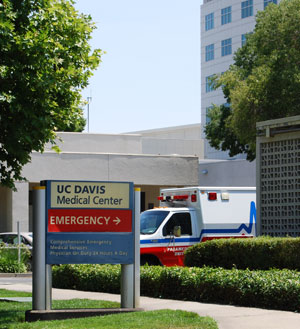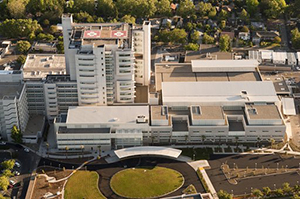UC Davis Medical Center Designated Level 1 Trauma Center
Highest-level trauma care for adults and children

The emergency entrance at UC Davis Medical Center. Historically, the hospital's trauma center has been among the nation's busiest.
UC Davis Medical Center is verified as a level I trauma center and a level I pediatric trauma center by the American College of Surgeons. This achievement recognizes the trauma centers' dedication to providing optimal care for injured patients.
Of the 112 level I trauma centers in the United States, less than 20 are verified for both adults and pediatrics.
"With our level I verification for both adult and pediatric trauma centers, we have achieved what few others have done," said Ann Madden Rice, chief executive officer of UC Davis Medical Center. "This is a terrific achievement, and reflects the expertise, hard work and high quality of the many physicians, nurses and ancillary staff who make our trauma centers an indispensable resource for the Sacramento and Northern California region."
UC Davis Medical Center provides level I trauma care for a region covering 6 million people in 33 counties, spread across 65,000 square miles.
Access to expertise whenever needed
A level I trauma center provides the highest level of surgical care to trauma patients. It has a full range of specialists and equipment available 24 hours a day and must admit at least 1,200 trauma patients a year. In 2008, the UC Davis Trauma Center admitted more than twice that amount, 2,836 patients. Historically, the trauma center has been among the nation's busiest.
Of the 112 level I trauma centers in the United States, less than 20 are verified for both adults and pediatrics.
A level I trauma center is required to have a certain number of surgeons and anesthesiologists, specialty services and ancillary services on duty 24 hours a day at the hospital. Among those specialties are orthopaedic surgery, neurosurgery, plastic surgery, emergency medicine, cardiac surgery, thoracic surgery, hand surgery, microvascular surgery, obstetrics and gynecology, ophthalmology, otolaryngology, urology, rehabilitation, radiology and internal medicine.
Such centers also are required to have an education program, a research program, a rigorous performance-improvement program, and community prevention and outreach programs. A level I trauma center also must keep an extensive database and submit data to the National Trauma Data Bank.
Researching better trauma care
The center has been instrumental in keeping Sacramento County's preventable death rate at or below less than half the national average.
Trauma is one of UC Davis Medical Center's most interdisciplinary research areas, and the medical center has the only trauma center in the region that conducts research on a regular basis. Research topics extend beyond surgery studies to include burns, traumatic emergencies, bone fractures, neurological disorders, childhood illness and disease pathology.
The UC Davis Trauma Prevention and Outreach Program works to decrease preventable death and injuries through education, research and community outreach. Reducing traffic deaths from impaired driving via increased DUI convictions is the aim of a current project under way by the Prevention and Outreach program. The program is developing a system to make sure law enforcement agencies know the blood-alcohol content of patients admitted after alcohol-related vehicle crashes.
When the system is fully developed, the program will provide education on uniform and consistent reporting procedures at all 11 level I and level II trauma centers in inland Northern California. In addition, UC Davis Medical Center will develop a standardized hospital procedure for obtaining a legal blood-alcohol level and teaching it to the same trauma centers.
Criteria for optimizing trauma care
The American College of Surgeons has guidelines for optimizing trauma care in the United States. Verified trauma centers must meet the essential criteria that ensure trauma care capability and institutional performance.
The Committee on Trauma's verification program does not designate trauma centers. Rather, the program provides confirmation that a trauma center has demonstrated its commitment to providing the highest quality trauma care for all injured patients. The actual establishment and the designation of trauma centers is the function of local, regional, or state health-care systems agencies, such as the local emergency medical services authority.
The level of verification is requested by the hospital. An on-site review of the hospital is conducted by a team of reviewers experienced in the field of trauma, which determines if the criteria for the requested level have been met.
UC Davis Medical Center is the leading referral center in the region for the most seriously injured or ill patients and the most medically complex cases, covering 33 counties, more than 65,000 square miles and 6 million residents. It operates inland Northern California's only level I trauma center, with comprehensive adult and pediatric emergency departments. The center has been instrumental in keeping Sacramento County's preventable death rate at or below 1 percent, which is less than half the national average. Studies show patients with specific critical injuries have better survival rates and functional outcomes at level I trauma centers and academic medical centers.



